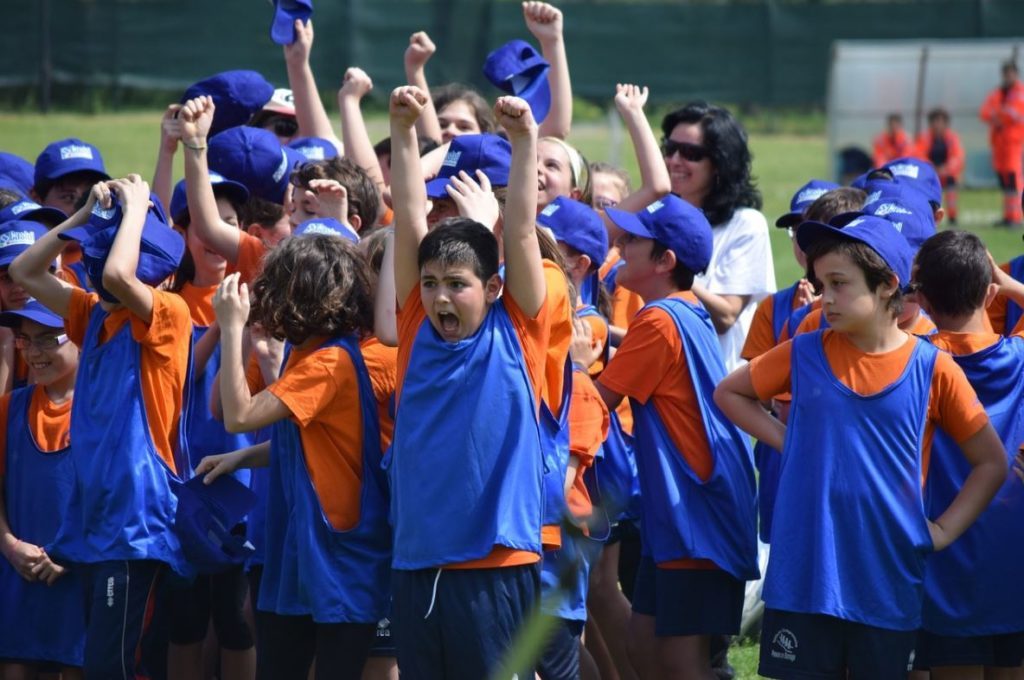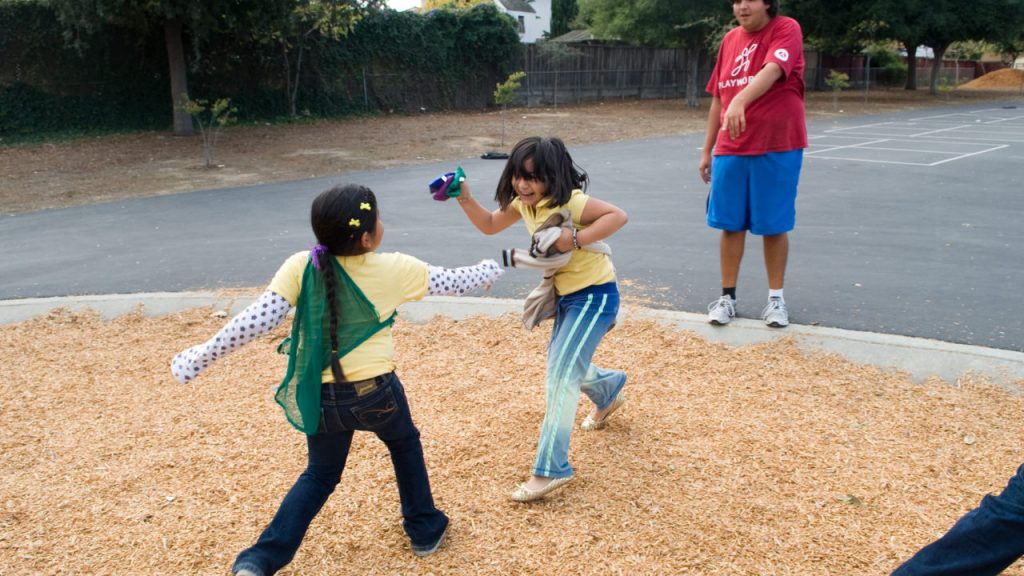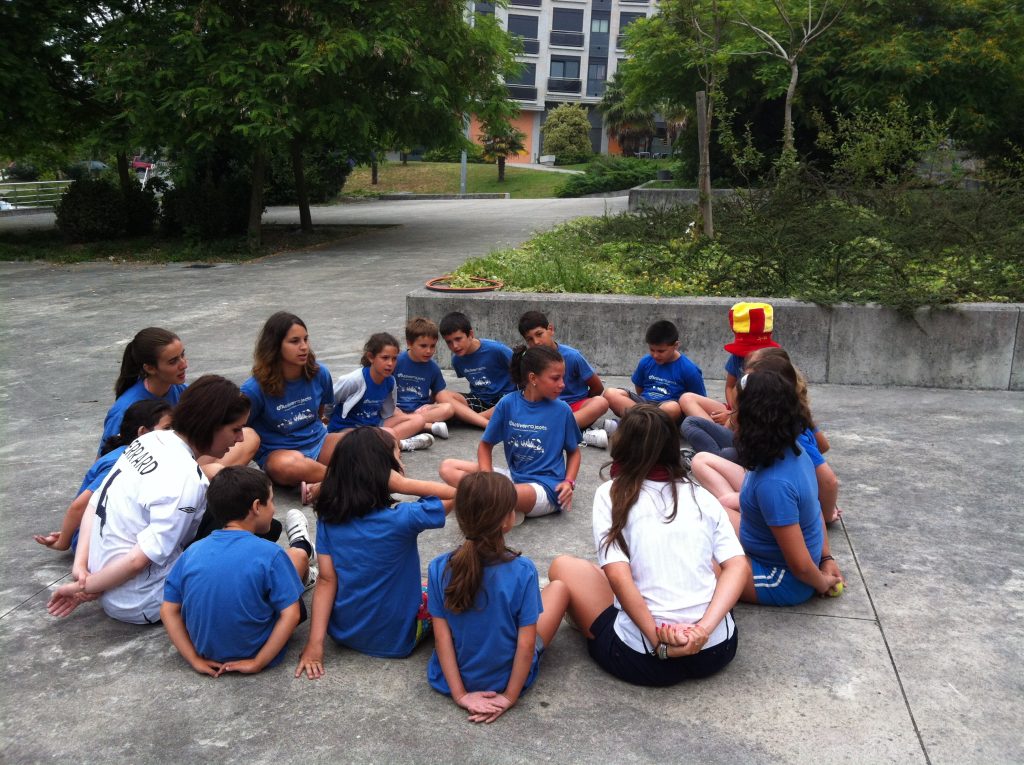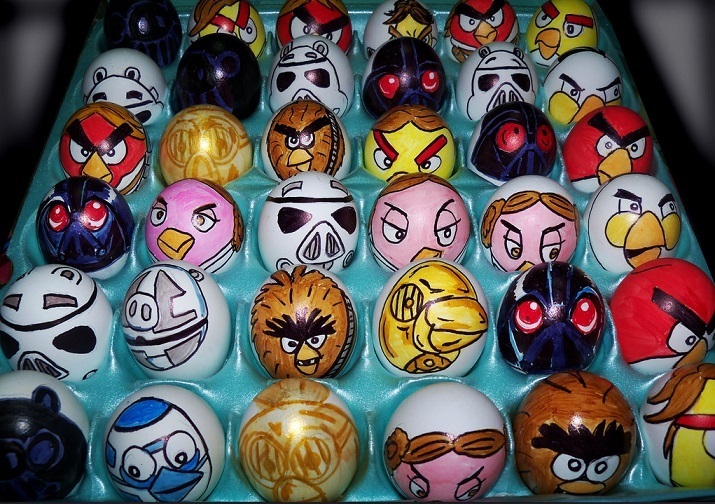Fruit basket, stealing the bacon, the cold wind blows, bob, the weasel, filler taboo, up and down, the five minute theatre, awesome architects, chess, tag, you’re it!, spell it out, elves, giants, and wizards, grab the dragon’s tail, kick the can, snake in the gutter, sudoku, blue block, colour code, master mind and guess the code, memory, group jump rope, human knot kids version, traffic lights, forehead dots, birthday line-up, trust walk, finger tip hula hoop, basketball passing lanes, soccer passing lanes, tag with a twist and sink the ship are some of the fun team building games for kids.
Read More: 7 Fun Card Game Ideas for Kids
Are you taking your children outdoors for a picnic. If you’re not sure what to do and if it’s your first time dealing with kids, then you should keep one important thing in your mind- kids are pumping with energy and need something to do in their spare time. Children love playing games, be it indoors or outdoors and if you can add some thrill and excitement into their life, you’ll find them being productive and successful as adults later on in life.
Games are a good way to develop a sense of empathy, emotional intelligence, intellectual and creative skills and builds upon existing hand-eye coordination and dexterity, all of which is needed in school and for future careers. Group teamwork activities for kids teach them how to collaborate and work with peers, both of which are essential elements of success and leadership in life. In this article, we will discuss 31 team building games for kids. Read on to find out what those games are:
Read More: 11 Best Running Games for Your Child
31 Fun Team Building Games & Activities for Kids
Fruit basket
A fruit basket is a fun game that involves using household items for a dose of indoor fun. You will need double-sided sticky tape, paper and pens. Split up the kids into four groups and ask them to pick their favourite themes such as fruits, scientists, dinosaurs, etc. Allocate numbers to each group and hand all players a single sheet of paper. Mix up the groups in a way that forms a circle (with one of them being at the centre) and begin the game by calling out the name of the group from the centre of the circle. The kids basically stand on their sheets of papers like floor markers and the player at the centre tries to steal a spot in the circle as the player from the circle (who is called out) tries to move to a new place.
Stealing the bacon
Don’t worry. There’s no bacon or stealing involved. Here’s what you have to do. You will need household items such as toys, fruits, books, shoes, etc. Line up 10-20 kids into two groups by splitting them apart, facing each other off in a parallel line (standing face-to-face). Create a gap between their two lines and place a toy right there. Assign numbers to each member of the two groups in a sequence that corresponds their counterpart group member (that is, the number 1 player on a team is correlated to the number 1 player on the b team). Call out a random number and whichever member (with the assigned number) manages to grab the object the fastest, wins.
The cold wind blows
This is a game that involves moving around chairs when conditions are met and trying to steal places while they are at it. You need 10-15 kids, space, chairs. Take the chairs and group them to form a circle. Leave out one chair from the total number of players and have everyone sit on them except one child who is designated as the centre. The centre child will say something along the lines of these statements while pointing out to one of the seated members-
“a cold wind blows for anyone who ate pizza last night.”
“a cold wind blows for anyone who plays cricket.”
“a cold wind blows for anyone who went to bed after 9 pm.”
The gist of the game is that whenever someone says “a cold wind blows for anyone who *inserts criteria/condition)” and points to a player, then the player who meets that condition will get up and move to another chair. Meanwhile, the child at the centre will try to steal the moving kid’s spot as he gets up and thus, the game continues as the number of players whittles down to one at the end of it.
Bob, the weasel
This game involves finding hidden objects and reading someone’s body language. It improves focus and attention. You will need a small object that’s not too noticeable or easy to spot at first glance (something discreet will do). Seat the kids to form a circle on the floor and choose someone who gets to be ‘bob, the weasel’ at the centre. Place their hands behind their backs and ask them to pass the objects from one person to another without bob noticing. If bob is able to find out who has the object, then that person becomes ‘bob, the weasel’ and switches out with the child at the centre and continues to play in a similar fashion.
Filler taboo
Kids sometimes use taboo or filler words such as ‘ah,’ ‘um,’ ‘hmm,’ and similar terms just like adults. This game will teach your kids to speak clearly and better articulate what they are trying to say. You need a bunch of subjects/topics for discussion and a timer. Make a list of topics on a sheet of paper and gather up the kids to form a circle. Let each kid talk about a topic of their choice briefly or for a few minutes. Anyone who uses a single taboo/filler word gets eliminated from the upcoming rounds, and the person who stands at the last is the winner.
Up and down
Up and down is a game where children look up and down for a specified period of time until pairs of two starts to get eliminated. Of course, it isn’t as simple as all this and here are all the rules you need to know. You need space, a number of kids. Gather up the kids to form a large circle and start the timer. As soon as you yell ‘look up!’ everybody looks up. The catch is that the kids get to look at their partners/others while looking up sideways. If any of their eyes meet, they scream and leave the circle, thus getting eliminated from the next round. The game continues until nobody remains. It’s fun, simple, and absolutely full of giggles!
The five minute theatre
Playing theatre in a matter of five minutes spurs up latent creativity and encourages instant problem-solving on the spot. Here’s how you play this game. You need everyday objects, space and time. Pick three kids to perform a skit and give them three to five minutes tops to do it on the fly. The others are free to hand them over props/objects for their skit performance onstage. Once the three to five minutes are up, the others get their turn in groups of three. This is also an awesome activity for kids’ workshops and summer vacation times.
Awesome architects
This game involves problem-solving skills and exercises a kid’s intellectual and creative limits. It’s perfect for kids who aspire to careers in stem fields and for raising the scientific genius in your household. You need glue, paper, clips, sticky tape and basic arts/crafts material depending on the project of your choice. Divide the kids into groups of teams and assign each of them the same materials. Give them an option on projects to work on ranging from newspaper bridge building to egg supports and book holders/simple crafts projects. Decide a time limit and explain what they are allowed to and not allowed to do to complete the project. Whichever team completes the project first successfully wins.
Chess
Challenge your little one to a game of chess. If he/she is old enough to understand rules and loves facing tactical challenges, then this game is a no-brainer for sure. You need two players, a chess board, and time. Explain to your little one the rules of chess, the significance of the black and white coloured pieces in the game. Talk about how the rook moves, the role of the knight bishop, what are checkmate and a stalemate and the differences between the two. You can even make them play a simulated game on pc with the cpu and encouraging them to play one-on-one with you afterwards. Other board games that are equally brain-tickling are ludo, bagamon, shogi, sudoku and snake and ladders.
Tag, you’re it!
Here’s a fun classic every kid loves – “tag, you’re it!” We all have fond memories of this game and here’s how you play if (especially if you’re new to it by any chance). You will need outdoor space, time and a number of kids. Gather a group of kids and decides who is the person who gets to be “it.” Ask the one who is “it” to go near a tree or structure outside, cover his eyes and count to 20. While he’s counting, ask everyone to hide somewhere far away or discretely and once he’s done the counting, encourage him to go searching for the others.
The game doesn’t end once he spots someone. The person who is “it” has to run and catch someone in the group. The person who gets caught becomes the next “it”, and in this way, it transforms into a never-ending loop of all-day fun.
Spell it out
Spelling out words using body language, stretching and flexing is a great way to stay in shape plus exercise those mental muscles while they’re at it. Here’s how you practice spells it out, outdoor style. You will need teams of four, space, and time. Take a paper and write down a list of four-letter words. Form kids into groups of four and ask each team to pose or spell out the words you say aloud using their fingers; body poses, movements and stretches. The team who is able to spell the most number of words correctly out of the rest using their bodies and movements wins.
Elves, giants, and wizards
A real-life twist to the classic rock, paper, scissors – if your kids love running and thinking when to act on the fly, then this is a game-changer.
You will need teams of two, a large space/play area and time. Mark out safe zones on the playing field and split the kids into groups of two.
Similar to rock, paper and scissors, the kid who creates-
A triangle with his hands on his head is the elf
The one who raises his arms is a giant
And, the one who holds his ears with the index finger extending out is the elf.
Now that we’ve got the basics down, if a giant faces a wizard, he is free to chase it. However, if the wizard enters the safe zone before the giant tags him, that doesn’t count. Once tagged, the wizard join’s the giant’s team. Giants beat wizards. Wizards beat elves. Elves beat giants. The game is over once any team has the most number of players in it.
All over
It’s all or none in this game and here’s how things swing. You will need footballs, tennis balls, basketballs, golf balls, etc. Split up the kids into two teams. Divide the play area into two territories, one belonging to each team. Start a countdown and let the balls get rolling! The team which manages to push in the most number of balls into their enemy’s territory within the designated time limit wins. Alternatively, if the team pushes all their balls into the enemy’s playfield and shouts “all over” also wins.
Grab the dragon’s tail
If developing swiftness, hand-eye coordination and dexterity is your aim, then look no farther and introduce your child to the game of grab the dragon’s tail! Here’s how you play it. You will need a large space to play outdoors and 10-15 kids. Gather the kids and ask them to join hands together in a line to form a dragon, side by side. The kid at the front is the dragon’s head while the last one behind is the tail. The rule of the game is to get the head catch the tail while the body in between tries to stop the head from doing so while not breaking the chain. If the head catches the tail, then the tail becomes the head and vice versa. Strategy and swiftness are the milestones achieved by playing this game.
Kick the can
If you’re kid’s bored playing “tag, you’re it!” Then here’s a little twist you can bring to it. You need a metal can, space, and 3 kids at the bare minimum. The rules are almost the same as “tag, you’re it” except the only difference is that the player tries to capture other players while they’re “it.” When “it” tags someone, he doesn’t switch himself out with the other player. Instead, the captured player is taken to a holding pen and stays there until the game is over. A metallic can is kept at a designated area of the playground, and if an un-captured player manages to kick the can while the “it” player is searching for others, then the captured players in pen get released. Once all the players are captured and placed in the holding pen, the game is over.
Snake in the gutter
A perfect game for primary and middle-school kids, this one encourages quick thinking and exercises natural reflexes. You need 6-12 kids and a large space. Have three to four kids line up in a linear way, side to side, by holding hands. Widen the gap between each child and make the gaps the gutter. The kids (holding hands) face the others in the opposite direction and become snakes. The others must try to pass through the gaps between the snakes (or through the gutters) and make it outside safely.
Whoever gets caught by the snakes has to join them and widen their formation. The game ends once the final player manages to pass through them. The trick to ensuring social, emotional and cognitive development in your kids is to make games fun and challenging. As long as they’re having fun and learning at the same time, it becomes a win-win situation. Try out this list of ideas, and we’re sure you’ll have a happy summer!
Sudoku
This game is a sensational hit for all ages and is known to arrest the decline of brain function in older people. It involves a grid with some numbers inside them and the rest is empty. The aim of the game is to fill up all the missing numbers. While it looks deceptively simple, the catch is that you cannot repeat the same number in the same row or column. The defining feature of this game is that it challenges your child to think 3-4 steps ahead and can help in planning.
Blue block
Blue block is a mobile game that has an interesting back-story to keep your child engrossed. The objective is simple: to free the blue dragon by rearranging the blocks so that it can reach the exit. It teaches kids that brute force isn’t always an option and simple logic can make their actions effortless!
Colour code, master mind and guess the code
Both the games have been clubbed together as they have similar objectives, that is, to figure out a randomized code. Hints are given which allow your child to deduce what the code might be. This helps your child to analyze the information provided and use it logically to figure out the code.
Memory
This game ranks high in recommended brain activities for kids as it is a memorization tool in its purest form. The objective of the game is to uncover all the similarly paired flashcards on a grid. A maximum of two cards can be revealed simultaneously after which the picture inscribed on them is hidden. Only if the cards are similar will their picture side be shown permanently. In this way, your child must remember the correct location of the cards to uncover all of them. This game helps improve the attention and focus of a child as this is crucial to the game.
Group jump rope
One might think that a jump rope is a solo sport or active activity for kids. In reality, however, it can be used as an awesome team kids’ building activity. First, you’ll need a really large jump rope, and ideally two adults or teens. Each adult and/or teen then holds the end of each side of the jump rope. The kids (depending on the length of the jump rope) then stand in the middle and jump together as the adults/teens swing the jump rope! It’s a great game because it is super simple, but also requires coordination and symmetry between two kids. It probably makes sense to start small with just two kids. And if there are many kids, then you can try competition, and score each pair of kids on how many successful jumps they land, or how long they can last without getting tangled up.
Human knot kids version
The famous human knot game is often tried with adults in co-working environments, but it is actually quite a fun and useful kid’s team building game and activity. Basically, have a group of kids sit together in a circle, ideally a minimum of 5-6 kids. Have each kid randomly grab (lightly!) Someone else’s wrist and hold onto it. Once everyone’s wrists are accounted for, instruct the kids to try and untangle themselves, but without letting go of anyone’s wrists! This is a really fun game which borders on strategy and chaos.
Obviously it is important to warn the kids to play this game slowly and gingerly, so that no one gets hurt. In some cases, it might be preferred to allow kids to release a wrist in order to properly untangle themselves. This is a great team building game for kids because it forces kids to work together toward a solution that everyone is aiming toward.
To make this kids game even more of a team building activity, you can instruct the kids that they cannot speak – thereby forcing them to strategize with body language, which likely increase the team chemistry that the game sets out to teach.
Traffic lights
This is a classic team building kids’ game which can be modified to increase the chemistry and team building between kids. The classic version involves an adult standing at the head of a room, intermittently shouting out ‘red’, ‘yellow’, or ‘green’. The kids stand at the opposite side of the room, and can run forward on green, must stop at red, and can walk slowly on yellow. The kids’ twist is to have a kid become the traffic light. And if there are enough kids, then they can be broken up into two separate teams.
And the team that completes the traffic lights challenge first, by getting all kids to their side first, wins! The team building aspect here is that the traffic light representative is on the other team, and the kids trying to race across the room are not racing against each-other, but rather collectively, in order to beat the other team of racers. This way instead of competing with each-other, they must collectively defeat the traffic light, and the other team.
Forehead dots
This is a really easy activity game to set up, but really hard for kids to solve! That’s precisely why this is a great team building activity for kids. Each kid gets a colored dot, which is then lightly taped onto their forehead. Each kid must then figure out what color dot is on their forehead, but obviously without asking any other kids for help. Depending on the number of kids, there will be only a few colored dots (so a few kids will have the same color). This is a great team building game, because it forces kids to communicate non verbally. The first team that arrives together (with the correct colored dots on their heads) is the winner!
Birthday line-up
You may have noticed a theme with our team building for kids activities: the fewer words spoken, the more effective the game. And that is no different for birthday line-up, in which kids are assembled into a group and must line up according to the order of their birthdays. Obviously it would be very difficult for kids to get this 100% correct on their first try, but it would not be outrageous for kids to get a sense of a general idea of each other’s birthdays by moving toward certain areas on the line. To make the game more compelling, give kids 1 minute to line up the first time, then observe the final line-up and tell them which kids are out of place, and then give them an additional minute to fix the positioning.
Trust walk
This is a classic kids’ team building activity which can be done in either pairs or groups. The ideal playing area is a safe, enclosed outdoors area (like a backyard or small park), in which there is a start area and finish area. One kid is blindfolded and spun around (not too fast – we don’t any kids getting dizzy!). Move the kid around a few steps so that he isn’t in the same exact position as he was before. Then have another kid come over and act as a guide. The guide must get the blindfolded kid to get to the finish area – but he can’t touch him, and can only give verbal cues.
To make the game more difficult, (and meaningful in terms of building team chemistry and such), the guide can’t use any directional language. So instead of simply saying “go forward 5 steps, then go left five steps”, the guide can only say directives such as “walk until you step on a branch”, followed by “now head toward the tree”, and the kid will be guided by the location of the voice of the guide. This game can be mixed up a bit to include multiple players, making it trickier and more competitive.
Finger tip hula hoop
There are a number of awesome hula hoop games which really pushes kids to work together and build chemistry. Our favorite is the helium hoop game, in which kids must work together as a group in order to lower the hula hoop to the ground. Every kid must only use their index fingers to lower the hoop (in unison) to the ground. Check out this great video below which shows how the finger tip helium hula hoop game is a great way to build team chemistry for kids.
Basketball passing lanes
If you can secure an outdoor court, have your kids’ line up on opposite ends of the court, and then instruct the kids to start running in the same direction. The premise is for each kid to pass the ball and to never hold it for more than 1 second. This forces the kids to constantly be looking for teammates, and to securely pass them the ball.
Soccer passing lanes
This game is the same premise as above, but replaces the basketball with a soccer ball. This is obviously trickier, since catching a soccer ball with legs is harder than catching a basketball with hands. To improve the quality of play, have the kids stand closer to each other so that the passing goes off in a simpler format.
Tag with a twist
Set up a normal game of tag, but instead of one kid being “it”, there will be two kids who will “it” be. These forces the pair to chase other kids together and in order to tag someone, both of the pair must successfully tag the target. This forces the pair to work together and build chemistry and rapport.
Sink the ship
The indoor team building game for kids requires a gymnasium, but is a highly entertaining game which requires teamwork and working together.
Make sure your kids learn everything about team-building from these games. Have fun!


















